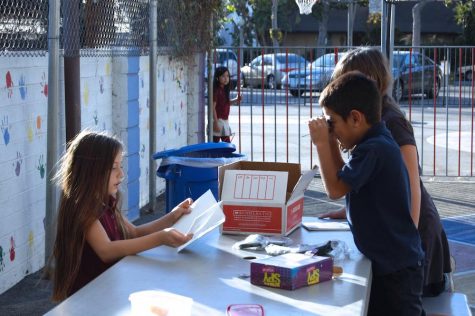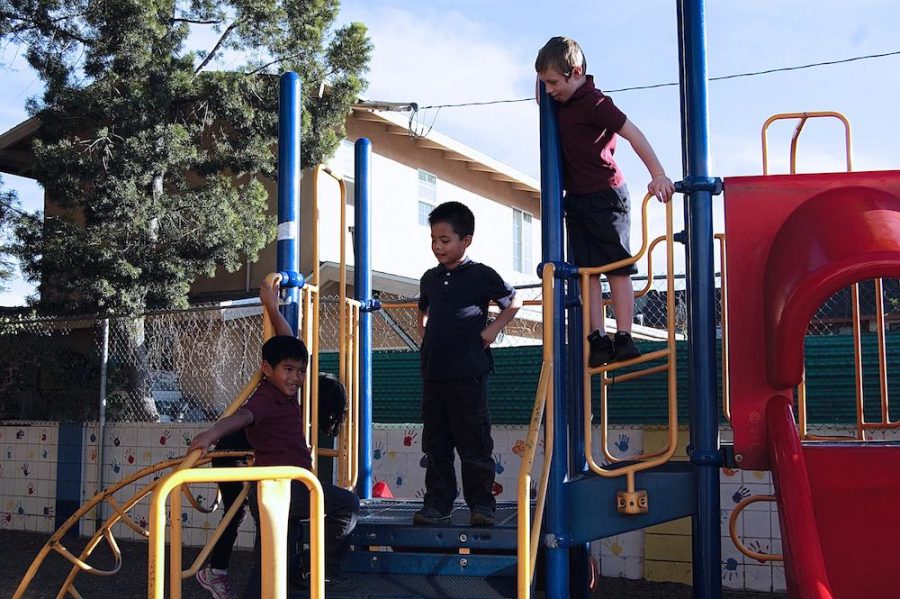The real denotation of after-school day care
Handling kids requires more than just experience
December 14, 2015
Shouting. Crying. Paper airplanes. Nothing can be more vexing than the day care experience. I planned to do a two-week shift at my old school, First Lutheran School of Glendale, watching kids as well as helping them out with homework in their after-school day care program. I had an idea of what to expect, but knowing how kids can be from past experience, I did not know how things would turn out.
The purpose of the day care industry is to enforce the needs of young children throughout the first vital years of their life. According to a recent study by the California Department of Education, an average of 271,275 kids spend time in a day care facility with ages ranging from zero to six years and older. In a private school, such as First Lutheran, there are around 20 kids most days, ranging from kindergarten to eighth grade present during after-school day care. The program lasts from 3:30 until 6 p.m. and costs parents $5 an hour.
According to the U.S. Bureau of Labor Statistics, as of May 2014, childcare workers hold more than 31,000 jobs in the country, receiving a mean wage of $46,950 per year (approximately $22.57 per hour). The employment of child care workers is expected to increase each year since the demand for childcare is gradually increasing.
It doesn’t take a lot to become a childcare provider in terms of education, since a high school diploma is all that is required. But what is required is the passion, patience and tolerance to deal with all different kinds of kids.
First day of my shift. Silence. The whole room was kept silent, and all the students were quietly doing their homework. I assisted one student named Joy, who needed help creating an introduction of herself in Spanish. With the quiet atmosphere, it was not hard to maintain her focus and get her to think; eventually, we were able to complete her Spanish homework in no time.
Second day. The same silent environment that I so appreciated for the time being. I could not believe how quiet a group of kids could be at 4 p.m. It was like a dream. Every student in the room was focused on doing their homework and nothing else.
I was able to help another student named Tabitha, who needed assistance with her English homework. Again, the quietness of the room made working with individual students much easier and Tabitha was able to understand and finish her homework in less than 30 minutes. This was my utopian idea of day care and the kids were not that bad — yet.

Eunice Ramilo
As the days went by, I noticed that the day care experience was getting harder to deal with. Each day, the kids got louder and more obnoxious than they had been before. Whether you put them inside or outside, their high levels of craziness stay the same. In turn, my patience and tolerance levels were put to the test.
After almost a week of doing day care inside, my supervisor and I decided to take the kids outside to give them some fresh air and play in the playground. Once you take kids outside and let them loose, things get scary. They were all scattered playing various games such as tag and hide-and-seek. I even got dizzy from the unbearable noise and chaos these kids were producing.
I ended up juggling both the responsibility of watching kids and tutoring at the same time in the same place. It was not the easiest thing to do. At this point, I realized that helping with homework was secondary, and my primary concern should be the kids’ well-being. I needed to make sure that no one got hurt or bullied; more importantly, I had to make sure that no child left with a stranger.
By the end of my two-week day care shift, I had already developed a good connection with the kids. They wanted me to stay and keep doing my volunteer shift at the school so that they would have someone to play and have fun with. That was when I realized that if I had put myself in a child’s mindset, my job as a day care supervisor would have been easier. For me, it was easier to relate to students close to my age rather than to the little kindergartners and first graders.
Clearly, day care is an activity that could only depend on a person’s personality, interests and experiences. Junior Lia Gharabeg said that she would enjoy working in day care because she likes kids and has the patience to be with them. She also said she has experience with children and has learned that kids like the kinds of people they can have a good time with. “If you act like the kids, you survive with the kids,” Gharabeg said.
Other students say they could not imagine working in a day care setting. Junior Marissa Pereira said that she would never work in day care because she dislikes spending long hours with young kids and lacks experience being around them as well. Pereira said that she also would not want to be held responsible for the welfare of other kids that she does not even know; their immaturity and stubbornness would only make life harder for her. “I can’t relate to them in a way so they listen to me,” Pereira said.
As for those who work in a childcare facility, day care serves as a daily challenge. Teacher Jelsomina Elsasser has been a day care supervisor for 12 years, and is now the only day care supervisor at First Lutheran for the elementary and middle school students. She thinks that her job as a day care supervisor is fun, yet it can be overwhelming.
The hardest part of her job, she said, is making sure the kids are safe, but she said that doing day care is more of an opportunity regardless. “I get to bond with kids outside a classroom environment, yet it doesn’t have to be serious,” Elsasser said. “I get to bond with different grade levels instead of my fifth graders that I normally teach.”

These guys are always on the lookout for trouble.
History and government teacher Eric Kursinski worked in day care at the Tom Sawyer Camps in Altadena, which offers both summer school and after-school day care. He has been a day care supervisor at the camp for about seven years since he started in high school. Kursinski said that the hardest part of doing day care was his exposure to the different age groups, various intelligence levels and unique cultural backgrounds. For him, it was hard to look from the kids’ perspectives and to connect with them on a one-to-one level.
However, Kursinski said that he enjoyed his experience being a day care supervisor. He said that he loved the spontaneous environment of day care, which is different from that of an office in which one already knows what to expect. “The same thing never happens twice,” he said.
He also said that doing day care led to his love for teaching. “I love connecting with students because they have different perspectives of the world,” Kursinski said. “Day care taught me to emphasize the positives instead of the negatives.”
